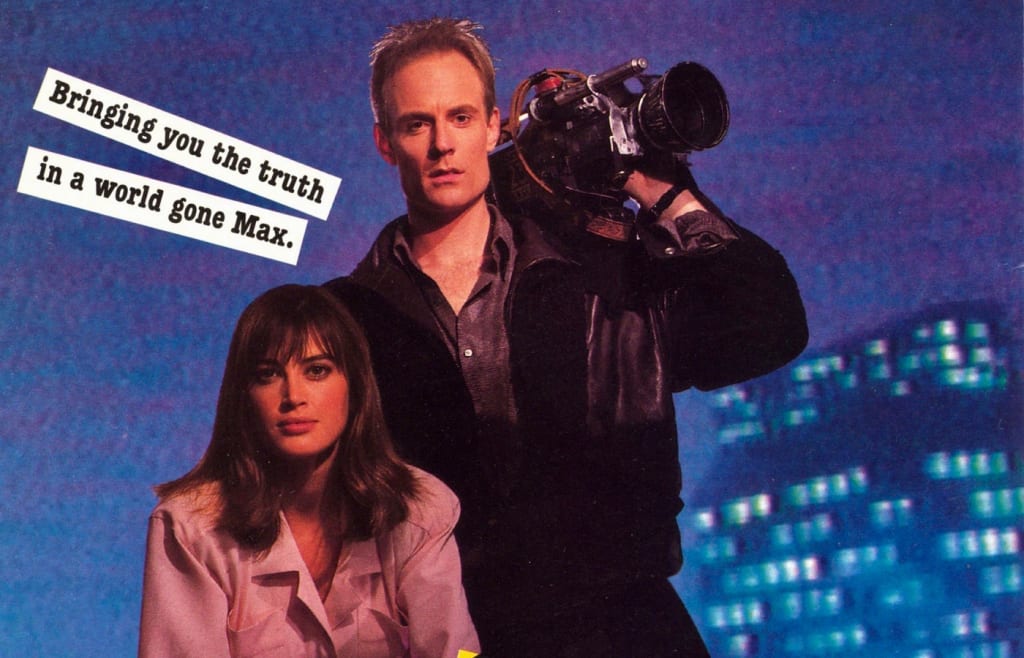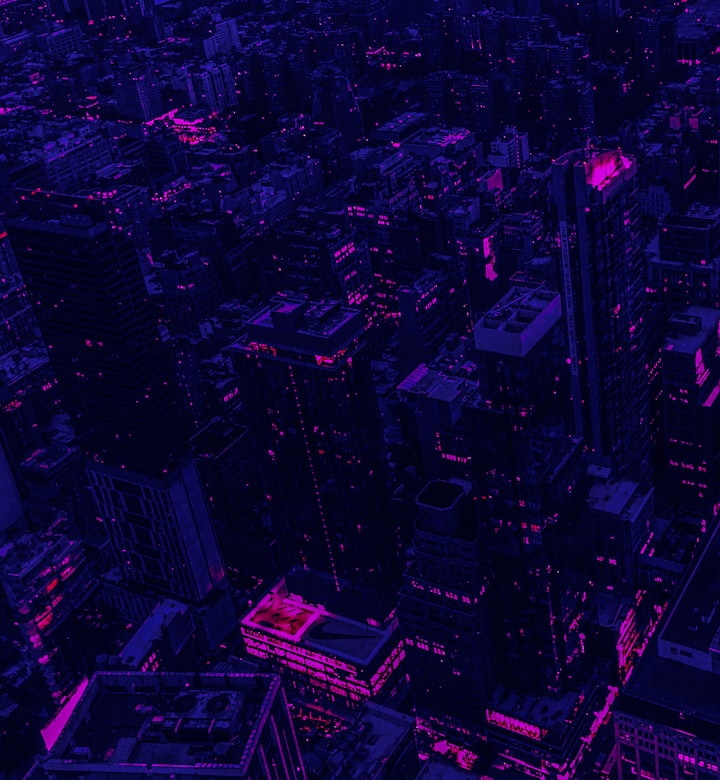
I well remember the mid-to-late 1980s: that was a very special, magical era for me, personally.
Or maybe not. Memory always plays you false.
At any rate, the world didn't seem as altogether harsh and threatening, the future quite so bleak, as what it seems today.
So it's a bloody good thing we had television movies like Max Headroom to disabuse us of any self-deceptive delusions about the future being like something from Star Trek. No. More like something from Neuromancer; more Gibson and Ballard, much more; less Roddenberry.
But, again, perhaps not. Our future seems less darkly comic. Where's the humor in mass shootings, opioid addiction, and Covid-19? Our future is bleaker than the dystopian fantasies and cyberpunk visions of thirty years ago, actually much more.
And our technology has far outpaced anything we conceived of at the time.
Max Headroom, a glitchy, stuttering parody of a television host with prosthetic hair, a weird, overly-defined face, and a computerized revolving background scene that looks like shifting multicolored neon tubes, was conceived originally as a fake AI character portrayed by Canadian actor Matt Frewer. Headroom hosted music videos on British television, and then a second series expanded on the format to include celebrity interviews. It was the heyday of cable television when a new world of creative possibilities was being explored in irreverent and experimental television shows like "Night Flight," and visionary young producers were eager to cash in on the burgeoning market for horror and science fiction visions. To that end, the fake "computer-generated" Max Headroom character was put smack dab (rather incongruously) in the middle of a short cyberpunk thriller, Max Headroom: Twenty Minutes Into the Future (1985), a dystopian telenovela about an investigative journalist, Edison Carter (played by Matt Frewer also), who risks his neck in the violent urban wasteland of the futuristic city in which he lives (which incidentally, is portrayed by obvious model skyscrapers).
Carter, along with his drop-dead gorgeous assistant Theora (Amanda Pays), whose main job is to surveil his movements sitting at a computer terminal with hilariously primitive and outmoded graphics, finds himself frequently in danger. The Newsroom at Network 23 is a dark, noirish, terminally gloomy place, wherein one wonders why someone doesn't just turn on the overheads.
The television executives and other ruling-class fat cats who run the network have created a special kind of advertising, "Blipverts", which compresses thirty seconds of advertising in just three seconds.
Subliminally beaming advertising to the central nervous system, preventing fat, lazy and apathetic viewers from switching channels (thus, lowering their ratings) Blipverts do have one small drawback: it causes some people to quite literally explode. This is shown, for all its comic-horror effect, and is one of the highlights of the movie.
Bryce (Paul Spurrier), the arrogant teen computer prodigy who invented Blipverts, explains that this is a result of the buildup of electrical impulses in the body sending signals to the brain--Blipverts overload the capacity for some very sedentary people to handle all of the resultant electrical stimulation. Tellingly, the television execs are mostly unconcerned with this, as the victims will all be elderly, obese, unemployed--the undesirables of society, in other words. This satire on corporate greed and commercial abuse of the public is most especially telling today, as pharmaceutical companies and other corporate entities are continually exposed and increasingly held accountable for their exploitative and harmful practices, practices they engage in all for the sake of profit.
Bryce creates an electronic parrot. This is the foreshadowing of AI to come. Edison sneaks into the Network 23 inner sanctum, sees the Blipverts video of the exploding man, and then has to get out of there as Bryce is watching him from his bath, in front of one of the primitive computers terminals. he fights a "hacker war" with Theora, which leads to Edison, who is trying to escape on a motorbike, hitting his head on a traffic barrier that has the words "Max Headroom 23.M" written prominently on it. Bryce has previously scanned Carter's mind, and "uploaded" (a word that didn't exist then) his ...consciousness into one of his AI computer projects. The result? Max Headroom, the quasi-artificial, stuttering, stand-up comic in the ever-shifting neon laser room, who wisecracks inane and cryptic-seeming non-sequiturs. (Or, whatever the intention of his dialog, it isn't amusing or funny.)
As comic relief, Max seems curious to have been dropped, like a blossoming orchid in a Stygian sewer, amidst the gloom and ugliness of the post-apocalyptic surroundings. His inclusion here at all seems weirdly incongruous with the downbeat atmosphere. But, perhaps that is a part of the absurdist vision of the filmmakers.
Carter, who isn't dead, is transported by two oafish thugs to a handy "body bank." It is here he awakes before having his organs removed.
His AI alter-ego, Max, is sold by the two goons (one of whom quotes Hamlet's line, " Tis now the very witching time of night, When churchyards yawn and hell itself breathes out, Contagion to this world...") to "Big Time" television, a pirate television station run by aging punk rocker "Blank Reg" (W. Morgan Sheppard) and his chain-smoking girlfriend Dominique (Hillary Tindall). Their viewership seems confined to a few homeless derelicts, virtual zombies who live on a rubble-strewn vacant lot with a few bizarrely placed tube televisions blasting Big Time shows (which are all bad videos).
After acquiring the bizarre, wisecracking Max, their rating skyrocket. Meanwhile, the head television exec from Network 23, Grossman (Nickolas Grace) is brought to Big Time's illustrious RV cum television broadcast station. He is here to reclaim Max Headroom or Carter...one or the other, one supposes, because he has complained bitterly to Bryce about the loss of Carter for Network 23's ratings (which are the only meaning he can find in life).
The denouement of the film has Carter, himself once more, confronting Grossman on camera; Max Headroom, the wisecracking AI comic creation, is unleashed upon the video airwaves. Or on cable. The End?
In 1988, an act of actual video piracy was perpetrated by persons unknown on Chicago station WGN, by an individual wearing a "Max Headroom" mask and costume, against a similar-looking neon-lighted background. The character referred to two separate broadcasts to "world's greatest newspaper nerds," Coca Cola, a popular news anchor, and ended his second ninety-second broadcast with an image of naked buttocks being swatted with a flyswatter. The perpetrators of the video hijack remain unknown to this day.

Such antics are today, unnecessary. the world of "pirate television" and "pirate radio," which was a futuristic threat bandied about by the media thirty years ago, never materialized, made superfluous by the internet, which now allows everyone a platform regardless of how insane they happen to be. Our technology has outpaced the cyberpunk vision of the future proffered by films such as Max Headroom. Our dystopian contemporary world makes the Mad Max visions of yesteryear seem hackneyed, trite; in some ways, almost quaint. Science fiction doesn't date well.
Of course, the absurdism of "Blipverts" as a concept is purely satirical. And it is dead-on. Corporations, propaganda, and exploitation of the masses, making them physically and psychologically ill in the relentless pursuit of profits (in a world where, indeed the richest of the rich get richer, while everyone else increasingly starves), is the endemic hallmark, the zeitgeist of our mutilated and disintegrating social fabric. Would they show us television commercials that would explode us? Only, one suspects, if the money came flowing in.
Sadly, there are no Edison Carter's in real life, to try and hold the rich and powerful accountable. We live in a world of micro-second attention spans, reality television, social media, and the constant narcissistic search for fame, attention, the "spotlight." people live artificial lives today, interacting through the world by machine, computer, digital image. False lives; unreal deaths. The "neural landscape" of the dystopia. J.G. Ballard, the genius of our fractured, fallen age, once quipped, in the punk magazine Re/Search that, "In the future, everyone will be living in a television studio." And he was so correct.
Taken in the light of contemporary life, Max Headroom seems dated, its societal predictions and piffling criticisms of the projected modern hellscape inspiring a kind of wry, knowing smile. We have seen the future brother, and, believe us, it's not just murder. It's somewhat worse.
But, it may make you nostalgic, nonetheless.
To the Max.
Max Headroom: Twenty Minutes Into the Future can be viewed for free on YouTube.
About the Creator
Tom Baker
Author of Haunted Indianapolis, Indiana Ghost Folklore, Midwest Maniacs, Midwest UFOs and Beyond, Scary Urban Legends, 50 Famous Fables and Folk Tales, and Notorious Crimes of the Upper Midwest.: http://tombakerbooks.weebly.com






Comments
There are no comments for this story
Be the first to respond and start the conversation.